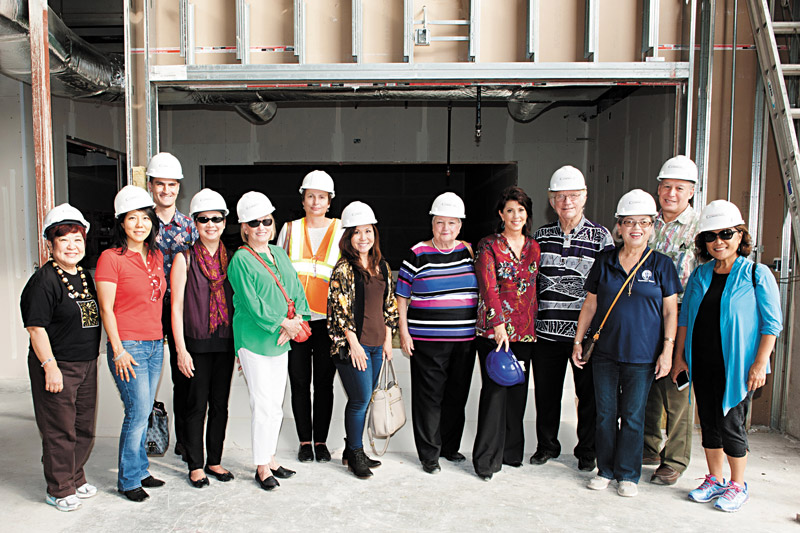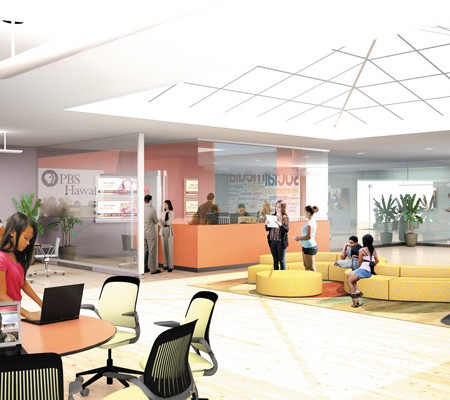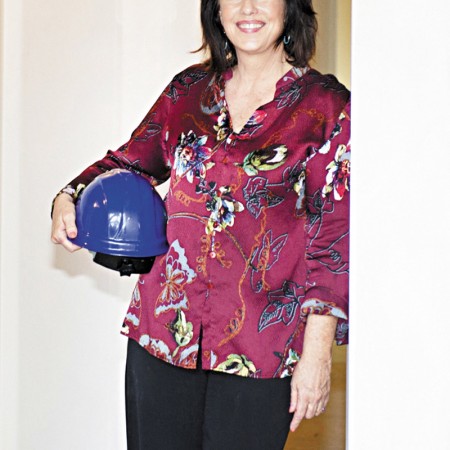Both Sides Of The Story

PBS Hawaii president Leslie Wilcox (holding blue hardhat) with the board of directors at the new, under-construction studio
In a world where traditional media is increasingly polarizing and social media allows you to shut out views you don’t like with a keystroke, how does one teach kids to have a broad world-view and an open mind?
Easy. Just give them the keys to the media and get out of the way.
This is the idea behind Hiki No, the first show of its kind in the country, where kids do everything from soup to nuts on a half-hour broadcast that PBS airs Thursdays in prime time.
“We looked at ourselves as an educational organization, and we said, ‘Are we only doing nice things? Maybe we should be doing more things that are hands-on, on the ground and have striking results in education,'” says Leslie Wilcox, president of PBS Hawaii. “This was a big risk — big bucks to start, a lot of focus and no one else was doing it, so we had to develop it as we went. If we aren’t willing to try something big and fail, then what are we here for?
“The results are kids learning 21st-century skills — the skills you learn in this program are the ones employers today want, so we think we are closing the achievement gap between affluent and lower-income students.”
The program owes its inspiration to the work of Candy Suiso and her Waianae Searider Productions, but takes it to a state level. Since 2011, students from 90 different schools from across the state research, write and film stories about the issues that matter to them, but are held to traditional journalistic standards of covering both sides of a story.
- An artist’s rendering of the new PBS Hawaii studios and student learning zone at Sand Island Road and Nimitz Highway, external and internal, which Leslie Wilcox has pushed. It is expected to be operational by May 2016
- Leslie Wilcox
That is a daunting task for an experienced journalist. So what happens when you ask children to live up to an expectation you cannot even find on a cable news network?
“It worked, much to our surprise and our glee!” says Robert Pennybacker, executive producer of Hiki No. “It has grown a lot because we have held the kids to really high standards and they have risen to them. I think it is some of the best storytelling on television because it is coming directly from them: their ideas, their interests. They are at an age where we have not screwed them up yet — they are in a pure form. As a teenager, your brain is pretty well developed, but they are not yet adults where they begin to learn prejudices and your mind starts closing. We are
catching them at the sweet spot; they are creating exceptional stories.”
The results have been award winning, as they have garnered 20 percent of the national awards for student news broadcasts. Each school uses its own film equipment, but for those who do not have the resources, PBS has a lending library on each island to help kids with the requisite tools.
They do stories about people, but not in a sensational way, rather in the curious manner of a child. Wilcox says the first stories she saw on transgender kids came from Hiki No, because the kids are not afraid to simply ask how they felt.
Another piece was done by students at Waianae Intermediate about a special-needs child at the school, a kid they saw every day but did not really know. They used this opportunity to find out what he thinks about every day, what he wants to do with his life and how people react to him.
“They don’t gloss over things or use a lot of platitudes. They are direct; they don’t try to make a grand conclusion because they are just learning, so it was very real,” says Wilcox, who took over at PBS in 2007 after more than three decades as a newswoman.
“They tell me: ‘Your generation likes bad news — we want to put a positive spin on everything.’ They are into who are you really, they don’t make judgments, there is no distaste, it’s just ‘Here it is, you decide.'”
Putting yourself in another’s shoes may be the most important exercise the students get out of the program.
“It is interesting getting the perspective of someone else, seeing their story of what they are going through,” says Anya Carroll, a Kalani High junior, “to be behind the camera and see how they act regarding their interests. We have a lot of diverse students at Kalani and they have a lot of hidden talents that they don’t really tell people about. It is really interesting to cover and know if that is their passion and what it means to them.”
They aren’t all cuddly stories. When Wilcox inquired if the students could do a story on bullying, they did, but they did it from the perspective of the bully, giving insight into why the student was a bully.
Or the Hawaiian Sovereignty charter school that wanted to tell its story, but Wilcox instructed them that they would have to cover the opposing view as well.
“They were so scared and so uninterested in the other person’s point of view until they met him,” says Wilcox. “Then they realized, ‘Oh, he doesn’t have an ax to grind — he really believes this and he has a reason and we can understand the reason. We don’t agree, but we are going to do him right.’ And they made a really beautiful piece.”
Some stories bring a perspective that somehow got missed by the media machine, like the uproar in 2010 about shearwaters that were being killed on Kauai because the football stadium lights were disorienting them. A lot of environmentalists were consulted, The New York Times even did a story on it, but it wasn’t until the students did their piece that another side of the story came out. It seems that Friday night was the only
time most of the adults could go to the games, so by moving the game times, many parents could no longer see their children play.
“We thought it was a great double threat. Besides just teaching skills, it would also fill a gap caused by the consolidation of media,” says Wilcox. “And we were wrong about the second part. Students are doing stories that adults never did — it is not filling that gap, it is bringing something new to the table.”
In many ways, it is a breath of fresh air in a world where the phrase “If it bleeds, it leads” is the common standard for news coverage.
“They are hopeful, they are positive, they are aware of how bad of a shape the world is in, but they are ready to solve problems,” says Pennybacker. “They do stories on heavy topics but they don’t tend to judge them. It is basically just this is the way it is. It’s reality; we are going to deal with it.
“It is fun to watch them learn, and when they learn by doing it, they learn really quickly. It is great to see light bulbs going off. We give them very blunt feedback because we don’t have a lot of time and we need to be very clear, and I often wonder, ‘How are they taking this?'”
They seem to be taking it stride, according to Carroll.
“I didn’t take it personally,” she says. “It was good to know what I needed to improve on, but it benefited me not just from that one video, but into the future with other videos as well. It was really helpful to me.”
Receiving the instruction and more importantly, getting to fix their mistakes themselves are the learning tools that hone their skills more quickly.
“It is learning by redoing.
We don’t tell them what to do; we let them know what it would need to meet adult PBS journalism standards,” says Wilcox, who has had other PBS affiliates asking her advice on starting up their own student news networks.
“The students regularly meet that standard and fill a puka in our weekly prime time news show. But the show is just the tip of the iceberg. The skills are all educational, it is an education project that informs the rest of the state.”
And by next spring, Hiki No and the rest of PBS Hawaii will be operating out of a new, currently under-construction studio at the corner of Sand Island Road and Nimitz Highway.
The future is indeed bright.








